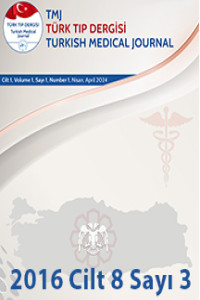Öz
Objectives: The aim of this study is developing a scale about the perception of traumatic childbirth on women.
Materials and Methods: The population of the study consisted of women aged 1840 years. In the first phase of the research, draft of the scale of traumatic childbirth perception was formed; in the second phase, this draft was submitted to the expert opinion; in the last phase, collecting data from participants, validity and reliability of the Scale of Traumatic Childbirth Perception were performed. The semi-structural sociodemographic information form which was developed by the researchers and the Scala Draft of The Traumatic Childbirth Perceptions and the Hospital Anxiety and Depression Scale was asked to the participants to fill in.
Results: Totally, 242 women with an average age of 28.7 were included in the study. 57.9% of the members of psychiatry or obstetrics departments were consulted for content validity. To determine the validity of a Traumatic Childbirth Perception Scale, factor analysis was used. The results of analysis by varimax rotation technique show that scale has 44.71% of one factor. Internal reliability coefficient of the test was found very high (The Cronbach’s alpha = .895).
Conclusion: In conclusion, it was maintained that the development of Traumatic Childbirth Perception Scale was valid and reliable and could be used in women.
Anahtar Kelimeler
Kaynakça
- 1. National Institute for Health and Clinical Excellence (NICE). Antenatal and Postnatal Mental Health: The NICE Guideline on Clinical Management and Service Guidance. Leicester (UK): British Psychological Society; 2007. https://www.ncbi.nlm.nih.gov/pub-med/21678630 (Erişim tarihi: Mart 2016).
- 2. Borg Cunen N, McNeill J, Murray JK. A systematic reviewj of midwife-led interventions to address post partum post-traumatic stress. Midwifery 2014;30: 170-84.
- 3. Beck TC, Watson S. Impact of birth ta-ruma on breastfeeing: a tale of two patways. Nursing Research 2008;57: 22-236.
- 4. Ayers S. Delivery as a traumatic event: prevalance, risk factors and treatment for postnatal posttraumatic stress disorder. Clinical Obstetrics and Gynecology 2004;47;552-67.
- 5. Oide E, Van Der Hart O, Kleber R, Van Son M. Posttraumatic stress following childbirth: A review. Clinical Psychology Review 2006;26:1-16.
- 6. Fenech G, Thomson G. A meta-synthe-sisto explore the psychosocial implications of a traumatic birth on maternal well-being. Midwifery 2014;30:185-93.
- 7. Beck CT, Watson S. Subsequent childbirth after a previous traumatic birth. Nurs Res 2010;59:241-9.
- 8. Soet JE, Brack GA, Dilorio C. Preve-lance and predictors of women’s experience of psychological trauma during childbirth. Birth 2003;30:36-46.
- 9. Gamble J, Creedy D, Moyle W, Webster J, McAllister M, Dickson P. Effectiveness of a counseling intervention after a traumatic childbirth: a randomized controlled trial. Birth 2005;32:11-9.
- 10. Garthus-Niegel S, Von Soest T, Vollrath ME, Eberhard-Gran M. The impact of subjective birth experiences on posttraumatic stress symptoms: a longitudinal study. Arch Womens Ment Health 2013;16:1-10.
- 11. Modarres M, Afrasiabi S, Rahnama P, Montazeri A. Prevalence and risk factors of childbirth-related post-traumatic stress symptoms. BMC Pregnancy and Childbirth 2012;12:88.
- 12. Grekin R, O’Hara MW. Prevalence and risk factors of postpartum posttraumatic stress disorder: A meta-analsis. Clinical Psychology Review 2014;34:389-401.
- 13. İşbir GG, İnci F. Travmatik Doğum ve Hemşirelik Yaklaşımları, KASHED 2014;1: 29-40.
- 14. Serçekuş P, Okumuş H. Fears associated with childbirth among nulliparous women in Turkey. Midwifery 2009;25: 155-62.
- 15. Ford E, Ayers S. Stressful events and support during birth: The effect on anxiety, mood and perceived control. Journal of Anxiety Disorders 2009;23:260-8.
- 16. Gamble JA, Creedy DK, Webster J, Moyle W. A review of the literature on debriefing or non- directive counselling to prevent postpartum emotional distress. Midwifer. 2002;18:72-9.
- 17. Furuta M, Sandall J, Cooper D, Bick D. The relationship between severe maternal morbidity and psychological health symptoms at 6-8 weeks postpartum: a prospective cohort study in one English maternity unit. BMC Pregnancy Childbirth 2014;7:14-133.
- 18. Czarnocka J, Slade P. Prevalence and predictors of post-traumatic stress symptoms following childbirth. British Journal of Clinical Psychology 2000;39: 35-51.
- 19. Anderson C. Construct Validity of the Childbirth Trauma Index for Adolescents. The Journal of Perinatal Education 2011;20:78-90.
- 20. Dencker A, Taft C, Bergqvist L, Lilja H, Berg M. Childbirth experience questionnaire (CEQ): development and evaluation of a multidimensional instrument. BMC Pregnancy and Childbirth 2010; 10:81.
- 21. Hodnett ED, Simmons-Tropea DA. The Labour Agentry Scale. Psychometric properties of an instrument measuring control during childbirth. Research in nursing & health 1987;10:301-10.
- 22. Wijma K, Wijma B, Zar M. Psychosomatic aspects of W-DEQ: A new questionnaire for measurement of fear of childbirth, Journal of Psychosomatic Obstetric Gynaecology 1998;19:84-97.
- 23. Beydağ D K, Mete S. Prenatal Kendini Değerlendirme Ölçeğinin Geçerlik Ve Güvenirlik Çalışması. Atatürk Üniversitesi Hemşirelik Yüksekokulu Dergisi 2008;11:16-24.
- 24. Fawcett J, Knauth D. The factor structure of the perception of birth scale. Nursing Research 1996;45:83-6.
- 25. Ip WY, Chan D, Chien WT. Chinese version of the childbirth self-efficacy inventory. Journal of Advanced Nursing 2005; 51:625-33.
- 26. Foa EB, Jaycox LH. Cognitive-behavioral theory and treatment of posttraumatic stres disorder. In: Speigel D ed., Efficacy and cost-effectiveness of psychotherapy: Clinical practice. Washington DC: American Psychiatric Association; 1999:45,23-61.
- 27. Foa EB, Cashman L, Jaycox L, Perry K. The Validation of a Self-Report 63 Measure of Posttraumatic Stres Disorder: The Posttraumatic Diagnostic Scale. Psychological Assessment 1997;9: 445-51.
- 28. Ayers S. Thoughts and emotions during traumatic birth: a qualitative study. Birth 2007;34:253-63.
- 29. Zigmond AS, Snaith PR. The Hospital Anxiety and Depression Scale. Acta Psychiatr Scand 1983;67:361-70.
- 30. Aydemir Ö. Konsültasyon-liyezon psikiyatrisinde yaşam kalitesi ölçümü: Kısa Form-36 (SF-36). 3P Dergisi 1999;7: 14-22.
- 31. Veneziano L, Hooper J. A method for quantifying content validity of health-related questionnaires. Am J Health Behav 1997;21:67-70.
- 32. Akgül A. Tıbbi Araştırmalarda İstatistiksel Analiz Teknikleri. 3. Baskı, Ankara: Emek Ofset Ltd.Şti; 2005.
- 33. Tavşancıl E. Tutumların Ölçülmesi ve SPSS İ le Veri Analizi. 5.Baskı, Ankara: Nobel Yayın Dağıtım; 2014;138-55.
- 34. Aksakoğlu G. Sağlıkta Araştırma Teknikleri ve Analiz Yöntemleri. İzmir: Dokuz Eylül Üniversitesi Rektörlük Matbaası; 2013:90-102.
Öz
Amaç: Bu çalışma, kadınların doğum eylemini travmatik olarak algılama düzeylerini belirlemek için bir ölçme aracı geliştirilmesi amacıyla gerçekleştirilmiştir.
Materyal ve Metot: Araştırmanın evrenini, 18-40 yaş grubu kadınlar oluşturmuştur. Araştırmanın birinci aşamasında travmatik doğum algısı ölçek taslağı oluşturulmuş, ikinci aşamada bu taslak uzman görüşüne sunulmuş ve üçüncü aşamada katılımcılardan veri toplanarak Travmatik Doğum Algısı Ölçeği’nin geçerlik-güvenirlik çalışması yapılmıştır. Katılımcılara araştırmacılar tarafından geliştirilen sosyodemografik bilgi formu, Travmatik Doğum Algısı Ölçeği taslak formu ve Hastane Anksiyete-Depresyon Ölçeği uygulanmıştır. Bulgular: Yaş ortalamaları 28,7 olan toplam 242 kadın çalışmaya dâhil edilmiştir. Katılımcıların %57.9’u evli, %52.9’u üniversite mezunu ve %57.8’i ev dışında çalışan durumundaydı. Kapsam geçerliği için psikiyatri öğretim üyeleri ve ebelik anabilim dalı öğretim üyelerinin oluşturduğu 12 uzmanın kanısına başvuruldu. Travmatik Doğum Algısı Ölçeği’nin yapı geçerliğini tespit etmek için faktör analizi yapıldı. Faktör analizinde varimax dik döndürme tekniği ile yapılan analiz sonucunda varyansın % 44.71’ünü açıklayan tek faktör belirlendi. Testin iç güvenirlik katsayısı oldukça yüksek bulunmuştur (cron-bach alpha= .895).
Sonuç: Çalışmamızın bulguları, Travmatik Doğum Algısı Ölçeği’nin kadınlarda travmatik doğum algısı düzeyini ölçmek için kullanılabileceğini göstermiştir.
Anahtar Kelimeler: Travma, doğum algısı, kadın.
Anahtar Kelimeler
Kaynakça
- 1. National Institute for Health and Clinical Excellence (NICE). Antenatal and Postnatal Mental Health: The NICE Guideline on Clinical Management and Service Guidance. Leicester (UK): British Psychological Society; 2007. https://www.ncbi.nlm.nih.gov/pub-med/21678630 (Erişim tarihi: Mart 2016).
- 2. Borg Cunen N, McNeill J, Murray JK. A systematic reviewj of midwife-led interventions to address post partum post-traumatic stress. Midwifery 2014;30: 170-84.
- 3. Beck TC, Watson S. Impact of birth ta-ruma on breastfeeing: a tale of two patways. Nursing Research 2008;57: 22-236.
- 4. Ayers S. Delivery as a traumatic event: prevalance, risk factors and treatment for postnatal posttraumatic stress disorder. Clinical Obstetrics and Gynecology 2004;47;552-67.
- 5. Oide E, Van Der Hart O, Kleber R, Van Son M. Posttraumatic stress following childbirth: A review. Clinical Psychology Review 2006;26:1-16.
- 6. Fenech G, Thomson G. A meta-synthe-sisto explore the psychosocial implications of a traumatic birth on maternal well-being. Midwifery 2014;30:185-93.
- 7. Beck CT, Watson S. Subsequent childbirth after a previous traumatic birth. Nurs Res 2010;59:241-9.
- 8. Soet JE, Brack GA, Dilorio C. Preve-lance and predictors of women’s experience of psychological trauma during childbirth. Birth 2003;30:36-46.
- 9. Gamble J, Creedy D, Moyle W, Webster J, McAllister M, Dickson P. Effectiveness of a counseling intervention after a traumatic childbirth: a randomized controlled trial. Birth 2005;32:11-9.
- 10. Garthus-Niegel S, Von Soest T, Vollrath ME, Eberhard-Gran M. The impact of subjective birth experiences on posttraumatic stress symptoms: a longitudinal study. Arch Womens Ment Health 2013;16:1-10.
- 11. Modarres M, Afrasiabi S, Rahnama P, Montazeri A. Prevalence and risk factors of childbirth-related post-traumatic stress symptoms. BMC Pregnancy and Childbirth 2012;12:88.
- 12. Grekin R, O’Hara MW. Prevalence and risk factors of postpartum posttraumatic stress disorder: A meta-analsis. Clinical Psychology Review 2014;34:389-401.
- 13. İşbir GG, İnci F. Travmatik Doğum ve Hemşirelik Yaklaşımları, KASHED 2014;1: 29-40.
- 14. Serçekuş P, Okumuş H. Fears associated with childbirth among nulliparous women in Turkey. Midwifery 2009;25: 155-62.
- 15. Ford E, Ayers S. Stressful events and support during birth: The effect on anxiety, mood and perceived control. Journal of Anxiety Disorders 2009;23:260-8.
- 16. Gamble JA, Creedy DK, Webster J, Moyle W. A review of the literature on debriefing or non- directive counselling to prevent postpartum emotional distress. Midwifer. 2002;18:72-9.
- 17. Furuta M, Sandall J, Cooper D, Bick D. The relationship between severe maternal morbidity and psychological health symptoms at 6-8 weeks postpartum: a prospective cohort study in one English maternity unit. BMC Pregnancy Childbirth 2014;7:14-133.
- 18. Czarnocka J, Slade P. Prevalence and predictors of post-traumatic stress symptoms following childbirth. British Journal of Clinical Psychology 2000;39: 35-51.
- 19. Anderson C. Construct Validity of the Childbirth Trauma Index for Adolescents. The Journal of Perinatal Education 2011;20:78-90.
- 20. Dencker A, Taft C, Bergqvist L, Lilja H, Berg M. Childbirth experience questionnaire (CEQ): development and evaluation of a multidimensional instrument. BMC Pregnancy and Childbirth 2010; 10:81.
- 21. Hodnett ED, Simmons-Tropea DA. The Labour Agentry Scale. Psychometric properties of an instrument measuring control during childbirth. Research in nursing & health 1987;10:301-10.
- 22. Wijma K, Wijma B, Zar M. Psychosomatic aspects of W-DEQ: A new questionnaire for measurement of fear of childbirth, Journal of Psychosomatic Obstetric Gynaecology 1998;19:84-97.
- 23. Beydağ D K, Mete S. Prenatal Kendini Değerlendirme Ölçeğinin Geçerlik Ve Güvenirlik Çalışması. Atatürk Üniversitesi Hemşirelik Yüksekokulu Dergisi 2008;11:16-24.
- 24. Fawcett J, Knauth D. The factor structure of the perception of birth scale. Nursing Research 1996;45:83-6.
- 25. Ip WY, Chan D, Chien WT. Chinese version of the childbirth self-efficacy inventory. Journal of Advanced Nursing 2005; 51:625-33.
- 26. Foa EB, Jaycox LH. Cognitive-behavioral theory and treatment of posttraumatic stres disorder. In: Speigel D ed., Efficacy and cost-effectiveness of psychotherapy: Clinical practice. Washington DC: American Psychiatric Association; 1999:45,23-61.
- 27. Foa EB, Cashman L, Jaycox L, Perry K. The Validation of a Self-Report 63 Measure of Posttraumatic Stres Disorder: The Posttraumatic Diagnostic Scale. Psychological Assessment 1997;9: 445-51.
- 28. Ayers S. Thoughts and emotions during traumatic birth: a qualitative study. Birth 2007;34:253-63.
- 29. Zigmond AS, Snaith PR. The Hospital Anxiety and Depression Scale. Acta Psychiatr Scand 1983;67:361-70.
- 30. Aydemir Ö. Konsültasyon-liyezon psikiyatrisinde yaşam kalitesi ölçümü: Kısa Form-36 (SF-36). 3P Dergisi 1999;7: 14-22.
- 31. Veneziano L, Hooper J. A method for quantifying content validity of health-related questionnaires. Am J Health Behav 1997;21:67-70.
- 32. Akgül A. Tıbbi Araştırmalarda İstatistiksel Analiz Teknikleri. 3. Baskı, Ankara: Emek Ofset Ltd.Şti; 2005.
- 33. Tavşancıl E. Tutumların Ölçülmesi ve SPSS İ le Veri Analizi. 5.Baskı, Ankara: Nobel Yayın Dağıtım; 2014;138-55.
- 34. Aksakoğlu G. Sağlıkta Araştırma Teknikleri ve Analiz Yöntemleri. İzmir: Dokuz Eylül Üniversitesi Rektörlük Matbaası; 2013:90-102.
Ayrıntılar
| Birincil Dil | Türkçe |
|---|---|
| Konular | Psikiyatri |
| Bölüm | Araştırma Makalesi |
| Yazarlar | |
| Yayımlanma Tarihi | 27 Kasım 2016 |
| Yayımlandığı Sayı | Yıl 2016 Cilt: 8 Sayı: 3 |



